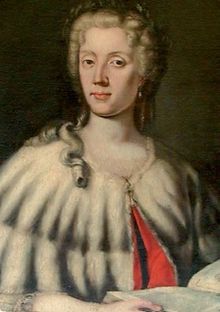
Back Laura Bassi Afrikaans لورا باسي Arabic لورا باسى ARZ Laura Bassi AST Laura Bassi Azerbaijani لائورا باسی AZB Laura Bassi BCL Лаура Баси Bulgarian Laura Bassi Catalan Laura Bassiová Czech
Laura Bassi | |
|---|---|
 | |
| Born | 29 October 1711 |
| Died | 20 February 1778 (aged 66) Bologna, Papal States |
| Nationality | Italian |
| Alma mater | University of Bologna |
| Known for |
|
| Spouse |
Giuseppe Veratti (m. 1738) |
| Scientific career | |
| Fields |
|
| Institutions | University of Bologna |
| Patrons | Prospero Lorenzo Lambertini (Pope Benedict XIV) |
| Notable students | Lazzaro Spallanzani |
Laura Maria Caterina Bassi Veratti (29 October 1711 – 20 February 1778) was an Italian physicist and academic. Recognized and depicted as "Minerva" (goddess of wisdom), she was the first woman to have a doctorate in science, and the second woman in the world to earn the Doctor of Philosophy degree.[1][2] Working at the University of Bologna, she was the first salaried female teacher in a university. At one time the highest paid employee of the university, by the end of her life Bassi held two other professorships.[3] She was also the first female member of any scientific establishment, when she was elected to the Academy of Sciences of the Institute of Bologna in 1732 at 21.
Bassi had no formal education and was privately tutored from age five until she was twenty. By then she was well versed in major disciplines including sciences and mathematics. Noticing her ability, Prospero Lambertini, the Archbishop of Bologna (later Pope Benedict XIV), became her patron. With Lambertini's arrangement she publicly defended forty-nine theses before professors of the University of Bologna on 17 April 1732, for which she was awarded a doctoral degree on 12 May. A month later, she was appointed by the university as its first female teacher, albeit with the restriction that she was not allowed to teach all-male classes. Lambertini, by then the Pope, helped her to receive permissions for private classes and experiments, which were granted by the university in 1740.
Bassi became the most important populariser of Newtonian mechanics in Italy.[1] She was inducted by the Pope to the Benedettini (similar to modern Pontifical Academy of Sciences) as an additional member in 1745. She took up the Chair of Experimental Physics in 1776, the position she held until her death. She is interred at the Church of Corpus Domini, Bologna.
- ^ a b Findlen, Paula (1993). "Science as a career in Enlightenment Italy: The strategies of Laura Bassi". Isis. 84 (3): 441–69. doi:10.1086/356547. JSTOR 235642. S2CID 144024298.
- ^ Frize, Monique (2013), "Famous Women in Science in Laura Bassi's Epoch", Laura Bassi and Science in 18th Century Europe, Springer Berlin Heidelberg, pp. 137–62, doi:10.1007/978-3-642-38685-5_10, ISBN 978-3-642-38684-8, retrieved 22 May 2020
- ^ Laura Bassi at Encyclopedia.com
© MMXXIII Rich X Search. We shall prevail. All rights reserved. Rich X Search